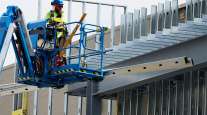US Economy Expanded More Than Previously Reported on Sunnier Consumer Spending

The U.S. economy expanded last quarter more than previously reported on a sunnier picture of household spending, the primary growth engine.
Gross domestic product rose at a 3.2% annualized rate in the three months ended in September, the fastest in two years, compared with an initial estimate of 2.9%, Commerce Department figures showed Nov. 29. The median forecast in a Bloomberg survey called for a 3% gain.
While business investment remains a weak spot, solid labor-market progress and steady household purchases kept growth on track ahead of the holiday shopping season. The figures are likely to reinforce projections for Federal Reserve policymakers to raise the benchmark interest rate in December for the first time this year, with inflation getting closer to the central bank’s goal.
“Growth is going to remain heavily reliant on the consumer, but consumers are in very good position to lead that charge,” with job gains, wage increases and low debt levels, said Russell Price, senior economist at Ameriprise Financial Inc. in Detroit. “Overall, it’s an encouraging sign for the path ahead.”
GDP represents the value of all goods and services produced in the economy. Analysts’ projections for the latest growth figure ranged from 2.8% to 3.3%. This is the second of three estimates for the quarter before annual revisions in July.
The revised growth figure mainly reflected changes to the pace of consumer spending and residential investment. Household purchases, which account for almost 70% of the economy, grew at a 2.8% annualized rate, stronger than the 2.1% pace initially estimated.
The adjustment reflected data from the Alcohol and Tobacco Tax and Trade Bureau, as well as figures on monthly retail sales, motor vehicle registrations and electricity usage, according to the Commerce Department.
Consumers also had more spending power in the three-month period than previously thought. Wages and salaries were up $110.2 billion from the second quarter, after an initial estimate of a $56 billion gain.
Residential investment was less of a drag, falling at a 4.4% pace, after an initial reading of a 6.2% drop, reflecting upward revisions to single-family housing and to data on dealers of building materials and garden supplies.
The upward revisions to growth were partly offset by a downward adjustment to nonresidential fixed investment, according to the Commerce Department.
The Nov. 29 report offered a first look at corporate profits for previous quarter. Before-tax earnings at companies increased 6.6% after declining 0.6% in the prior three-month period. Profits rose 2.8% from a year earlier, the first year-over-year gain after five quarters of declines. The gain in profits is a positive sign for business investment, which has been missing for a large part of the seven-year expansion.
Inventories grew at a $17 billion annualized rate from July through September and added to growth for the first time since early 2015.
Net exports were revised up slightly and added 0.87 percentage point to GDP, the most in almost three years, compared with an initially estimated 0.83 point. The pickup was probably temporary because it was largely attributable to an increase in exports of soybeans.
Stripping out inventories and trade, the two most volatile components of GDP, so-called final sales to domestic purchasers increased at a 1.7% rate, compared with a previously reported 1.4% pace.
Corporate spending on equipment decreased at a 4.8% annualized pace in the third quarter, more than the initially estimated 2.7% and subtracting 0.28 percentage point from growth, the report showed. Those outlays had declined 2.9% in the prior three months.




